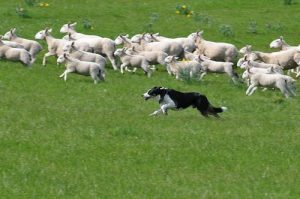Some dogs these days are spoiled pretty rotten, and will never know a days’ work in their lives. We love them just the same, and spend our time taking them for walks and giving them treats. Other dogs have to work for a living. There are many different types of working dogs, some have been bred over centuries to have the right attributes for their particular career path, while others can simply take up positions, thanks to their good nature and impeccable manners.
Bird dogs
We’re talking Retrievers, Labradors, Pointers, Spaniels, and many more. These dogs have been developed in order to help hunters find and/or then retrieve fowl. When the bird is found some breeds like spaniels are trained to “flush” the birds out. While other breeds like Setters are to remain still and they will “point” their muzzle in the direction of where the birds are located. The retrievers will go out and retrieve the bird and bring it back to the hunter undamaged – retrievers are to have a “soft mouth” so not to bite too hard on the prey. Many of these breeds are extremely popular as pets because of their desire to learn and please. Keep in mind they may have 1. have boundless energy (probably much more than you have) and 2. love water and may jump into water at every available opportunity – even dirty, stinky water–just before getting into the car.
Herding dogs

This includes Border Collies, German Shepherds and other “Lassie” type dogs. These have been bred, specifically, to help move livestock around the ranch, which means that not only do they have limitless energy but you may also find “Laddie” herding the cat from next door or the kids into the corner of the yard. Herding dogs can be classified as heelers, headers or tending dogs. Heelers push or nip at the heels of animals while headers like the Border Collie come straight on and face the animal with a “stare”. The tending dogs, like the German Shepherd act more as a fence or barrier to guide the animal in the desired direction. These type of dogs need lots of stimulation and they make great competitors at agility classes. Otherwise, without proper stimulation you may find that they make their own entertainment involving chewing up your slippers.
Tracking dogs
This includes breeds like Beagles, Coonhounds, and Bloodhounds. They have an amazing sense of smell–well, that is what they were bred for–to track prey using their noses. There are essentially 3 phases for tracking. 1. Searching phase – the dog takes small quick sniffs as they quickly try to pick up the scent. 2) Deciding Phase – Once they come across the scent they slow down and take longer sniffs and attempt to determine which direction to follow the scent. 3). Tracking phase – after they have determined the direction they move more quickly and sniff at a steady pace. Tracker dogs, whether formally trained or not typically love to follow a scent and they have been known be so hot on a trail that they forget their way home. It is said that as their noses are switched on, their ears may be switched off, and they’ll be completely tun out your voice without appropriate training.
Assistance Dogs
Rather than being bred for it, these dogs just have a terrific nature and intelligence, which lends them to being trained to assist people with disabilities. Mixed breeds can make terrific Therapy Dogs and really enrich the lives of many animal lovers. Assistance dog can be classified as either Hearing dogs, Guide Dogs, or Services Dogs. Hearing dogs assist people who are deaf or have hearing impairments by alerting them to important sounds like the doorbell or fire alarms. Guide Dogs assist people who are visually impaired by guiding them around obstacles and to places like the store. Services dogs are trained to assist people with hearing or visual impairments as well as those with Autism or seizures. Personality is the biggest asset for guide and other types of assistance dogs – they must be calm, loyal, faithful, obedient, and properly trained. These dogs have positively enhanced the lives of millions of people around the world, enabling many of them to live comparatively independent lives.
Photo: Courtesy of Arbutus Photography via Flickr (CC by 2.0)









